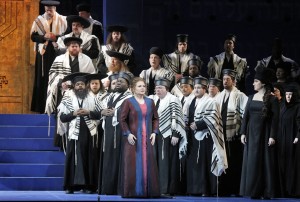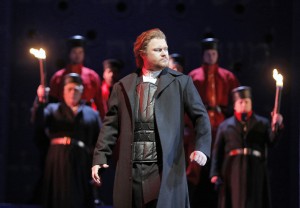STAGNANT STAGING AND CRAZY COSTUMES,
BUT THE CAST AND CHORUS CAPTIVATE
There’s a good reason why Verdi’s operas are typically described as “grand opera.” They’re big and bold, requiring massive orchestras and choruses. Soloists need strong voices with ample range and power. If this makes them somewhat formidable to produce, then Nabucco has a reputation for being doubly difficult. The pity with this production is that Lyric Opera didn’t put as much care into choosing the director and designers as it did into casting the conductor and soloists. For the simple truth is that even the music suffers in this stodgy production.
The fault does not lie in Verdi’s score, which contains some of his most memorable and beloved music, including the rousing chorus “Va pensiero.” Nabucco was the 28-year-old composer’s first operatic success. Working with Temistocle Solera, whose libretto borrows from Antonio Cortesi’s ballet Nabuccodonosor and Auguste Anicet-Bourgeois’ and Francois Cornu’s play Nabuchodonosor, Verdi tells the story of an oppressed people: the ancient Jews in the sixth century BC. Having destroyed Jerusalem, King Nebuchadnezzar (Nabucco) carries them off in exile to Babylon. It’s a story that would have been immediately familiar to his largely Catholic audience, and likely resonated with the Milanese at La Scala, where Nabucco debuted, who suffered under Austrian rule.
Although inspired by the Hebrew Scriptures, especially by the book of the prophet Jeremiah, Nabucco’s characters are mostly 19th-century fictions. Chief among these are Nabucco’s two daughters, Fenena and Abigaille, who vie for the throne during their father’s madness (inflicted by the God of the Jews in response to Nabucco’s blasphemy). And there is a very peripheral love triangle involving Nabucco’s daughters and Ismaele, nephew of the Jewish king.
Perhaps more so than in any other Verdi opera, the chorus is truly the star. In Nabucco, it is primarily used as a vehicle to express the anguish and aspirations of the beleaguered Jews. Under Michael Black, the Lyric Opera Chorus sings outstandingly with one voice.
As the ruthless, power-hungry Abigaille, Tatjana Serjan gives one of the most spectacular performances of the current season. Following on from her impressive Lyric debut last year in Puccini’s Tosca, the Russian soprano proves that she has the technique and physique to take on some of the repertoire’s most challenging roles. While by no means effortless, her capable acting, vocal power, wide range, confident coloratura and fluid phrasing are incredibly compelling and absolutely enjoyable.
Serbian baritone Željko LuÄić sings the title role with great grace and sensitivity. Although his initial entrance in Act I is underwhelming, LuÄić more than adequately fills his role from the point when his character goes mad onwards. Making his Lyric debut as Zaccaria, high priest of the Jews, Russian bass Dmitry Belosselskiy delivers a commanding and powerful performance. He easily holds his own against the chorus, especially in “Del future nel buio discerno,” which follows “Va pensiero.”
Despite a cast of talented singers and Carlo Rizzi’s energetic conducting, Nabucco suffers under the weight of poor design and direction. Michael Yeargan’s bulky, abstract sets are so unwieldly that uncomfortably long pauses ensue during scene changes, thereby depriving the opera of its natural momentum. Moreover, they inhibit the cast from moving about onstage. Consequently, there’s a lot of standing around. Thus, Matthew Ozawa’s static, uninspired direction not only fails to convey the dynamic energy of Verdi’s score, it detracts from it.
 Even the lighting design is weak; it’s only interesting feature is the projection of Hebrew texts. One feels that Duane Schuler could have done much more to convey Nabucco’s madness through appropriate lighting effects. Instead, the audience has to rely completely on the king’s own words. (It should perhaps be mentioned here that the supertitles were too often entirely absent.)
Even the lighting design is weak; it’s only interesting feature is the projection of Hebrew texts. One feels that Duane Schuler could have done much more to convey Nabucco’s madness through appropriate lighting effects. Instead, the audience has to rely completely on the king’s own words. (It should perhaps be mentioned here that the supertitles were too often entirely absent.)
And then there are Jane Greenwood’s ridiculous costume designs. She clothes the opera’s eponymous king in an ill-fitting, red velvet suit more reminiscent of Santa Claus than a Middle Eastern potentate! It’s hard to take him seriously in this guise. It’s almost equally hard not to laugh when the chorus appears to sing “Va pensiero” wearing what appears to be pajamas. This is all downright distracting’”and disappointing. Judging by the historical photos in the program, both costumes and sets were recycled from Lyric’s 1997-98 production of Nabucco.
The present production of Verdi’s Nabucco is only Lyric Opera’s third in a history lasting sixty-one years. Thus, Chicago audiences aren’t likely to have the opportunity to hear it again for some time. If for this reason only, one must recommend it despite its substantial flaws.
photos by Cory Weaver and Andrew Cioffi
 Nabucco
Nabucco
Lyric Opera of Chicago
Civic Opera House
20 N. Wacker Drive
ends on February 12, 2016
for tickets, call 312.827.5600 or visit Lyric Opera
for more info on Chicago Theater,
visit Theatre in Chicago










